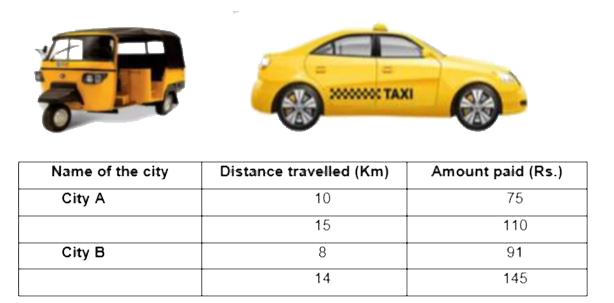Some migratory birds travel as much as 15,000 km to escape the extreme climatic conditions at home. Write the distance in metres using scientific notation.
To convert the distance of 15,000 km into meters and express it in scientific notation, we can follow these steps:
1. Identify the Conversion Factor:
We know that 1 kilometer (km) is equal to 1,000 meters (m).
2. Convert Kilometers to Meters:
To convert 15,000 km to meters, we multiply by the conversion factor:
15,000 km×1,000 m/km=15,000,000 m
3. Express the Number in Scientific Notation:
The number 15,000,000 can be expressed in scientific notation. To do this, we need to write it in the form of a×10n, where 1≤a<10 and n is an integer.
- We can express 15,000,000 as 1.5×107 because:
15,000,000=1.5×107
4. Final Answer:
Therefore, the distance of 15,000 km in meters expressed in scientific notation is:
1.5×107 m
Summary:
The distance of 15,000 km is equivalent to 1.5×107 meters in scientific notation.
---
We know that 1 kilometer (km) is equal to 1,000 meters (m).
To convert 15,000 km to meters, we multiply by the conversion factor:
15,000 km×1,000 m/km=15,000,000 m
The number 15,000,000 can be expressed in scientific notation. To do this, we need to write it in the form of a×10n, where 1≤a<10 and n is an integer.
- We can express 15,000,000 as 1.5×107 because:
15,000,000=1.5×107
Therefore, the distance of 15,000 km in meters expressed in scientific notation is:
1.5×107 m
The distance of 15,000 km is equivalent to 1.5×107 meters in scientific notation.
Topper's Solved these Questions
- BOOK - NCERT EXEMPLARCHAPTER - EXPONENTS AND POWERSEXERCISE - THINK AND DISCUSS2videos
EXPONENTS AND POWERS
- BOOK - NCERT EXEMPLARCHAPTER - DIRECT AND INVERSE PROPORTIONS EXERCISE - THINK AND DISCUSS2videos
DIRECT AND INVERSE PROPORTIONS
- BOOK - NCERT EXEMPLARCHAPTER - INTRODUCTION TO GRAPHS EXERCISE - EXERCISE86videos
INTRODUCTION TO GRAPHS
Similar Questions
The speed of a train is reduced from 60 kmh to 15 kmh whilst it travels a distance of 450 meters, if the retardation be uniform, how much distance it will travel before coming to rest.
View SolutionThe speed of a train is reduced from 36km/h to 9km/h whilst it travels a distance of 50 metres, if the retardation be uniform, how much further it will travel before coming to rest ?
View Solution
Knowledge Check
- Question 1 - Select One
If some migratory birds travel as much as 15000 km to escape the extreme climatic conditions at home, then the distance in metres using sciertificnation is:
A1.5×104mB1.5×105mC1.5×106mD1.5×107m - Question 2 - Select One
Pune-based organisation____ conducted a study using a 15% M-15 methanol blend in vehicles and tested them for 3,000 km to evaluate emissions in real-world conditions as well as to check the performance of the vehicles.
AAutomotive research Association of India (ARAI)BResearch Association of India (RAI)CAutomotive Organisation (AO)DVehicle Organisation of India (VOI) - Question 3 - Select One
Prabhu travelled from his house a distance of 20 kms to his friend's house. After some time he left his friends house and took a turn towards right and travelled 15 kms to reach a park. After resting for a while, he again started and turned to right and travelled 18 kms to reach a petrol pump. From there he again turned right and covered a distance of 15 kms. How many km more he has to travel to reach home?
A2 kmsB18 kmsC21 kmsD23 kms
A light year is the distance that light can travel in one year.
1 light year =9,460,000,000,000 km.
a. Express one light year in scientific notation.
b. The average distance between Earth and Sun is 1.496×108 km. Is the distance between Earth and the Sun greater than, less than or equal to one light year?
 View Solution
View SolutionIt is common that Governments revise travel fares from time to time based on various factors such as inflation ( a general increase in prices and fall in the purchasing value of money) on different types of vehicles like auto, Rickshaws, taxis, Radio cab etc. The auto charges in a city comprise of a fixed charge together with the charge for the distance covered. Study the following situations

Situation 1: In city A, for a journey of 10 km, the charge paid is Rs 75 and for a journey of 15 km, the charge paid is Rs 110.
Situation 2: In a city B, for a journey of 8km, the charge paid is Rs91 and for a journey of 14km, the charge paid is Rs 145.
The graph of lines representing the conditions are: (situation 2)View SolutionThe Arctic tern is a bird which travels from the Arctic to the Antarctic region and then back again. Hence it sees two summers in a year. On an averge, Arctic terns travel a distance of 70,000 km annually. This is an example of
View SolutionIf I travel by bus, I reach my office 15 min late, and if I travel by car, I reach 10 min early. If the distance between my home and my office is 25 km, then the difference of the reciprocals of average speeds of the bus and the car, is second per metre is:
यदि मैं बस से यात्रा करता हूँ, तो मैं अपने कार्यालय 15 मिनट देर से पहुँचता हूँ तथा यदि मैं कार से यात्रा करता हूँ, तो में 10 मिनट पहले पहुँच जाता हूँ | यदि मेरे घर से मेरे कार्यालय की दूरी 25 किमी है, तो बस और कार की औसत चाल के पारस्परिक का अंतर (मीटर प्रति सेकंड में ) है :View SolutionAstronomical distances are so large compared to terrestrial ones that much larger units of length are used for easy comprehension of the relative distances of astronomical objects. An astronomical unit (AU) is equal to the average distance from Earth to the Sun, 1.50×108km. A parsec (pc) is the distance at which 1 AU would subtend an angle of 1 second of arc. A light year (ly) is the distance that light, traveling through a vacuum with a speed of 3.00×105 km/s, would cover in 1 year.
Express a light - year and a parsec in kilometers.View Solution

